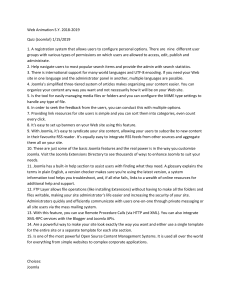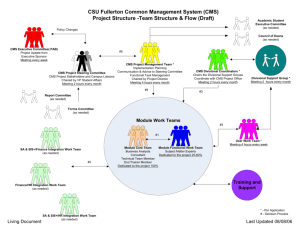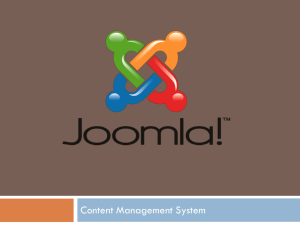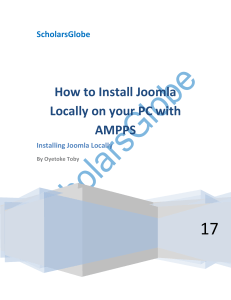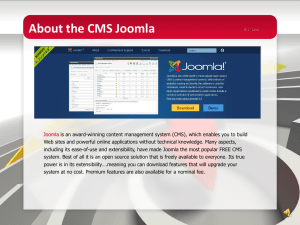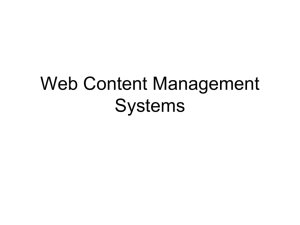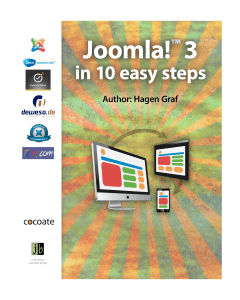Sample School Website - Sydney Region School ICT Website
advertisement
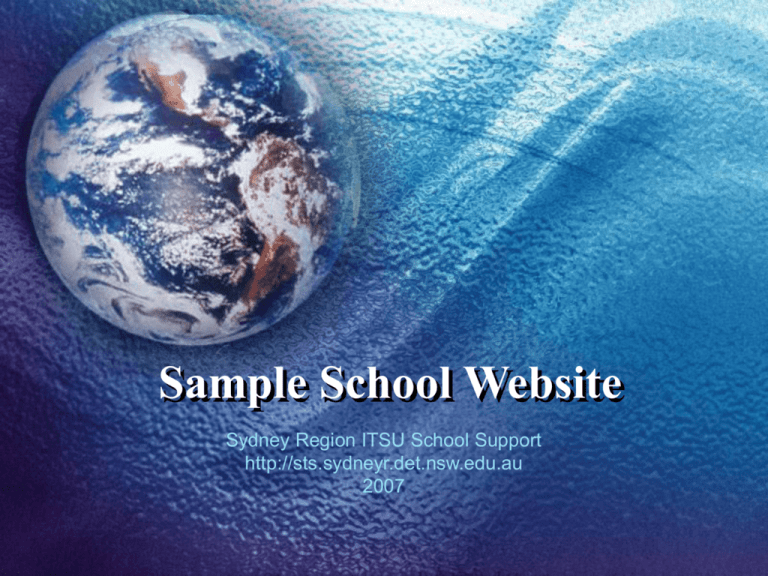
Sample School Website Sydney Region ITSU School Support http://sts.sydneyr.det.nsw.edu.au 2007 Website Project Page • http://sts.sydneyr.det.nsw.edu.au • SR Projects • Sample School Website Warning Some Technical Skills are required!!!!!!! Agenda • • • • • • • • • Why? What is wrong with the DET webspace? One Solution. What is a Content Management System? What is Joomla? Requirements. Installation Templates Working with Joomla Next Step? What is wrong with the existing School Webspace Site? • Can only host static pages – no dynamic content possible. • Can not be edited from home (easily) • Is not easy to maintain and change. • Can not easily provide extended features such as Dynamic calendars, forms, Picture Galleries... • Restricted content not easy to setup. • Everyone who edits the site, needs the ftp password – hard to maintain security. The Solution • Establish a dynamic site using a Content Management System. • Site can be hosted: – By external webhosting service (Costs money) – at school site on a server using a “reverse proxy” What is a Content Management System? • Wikipedia – “a web content management system is software for web site management” – A web content management system is a computer system used to manage and control a large, dynamic collection of web material (HTML documents and their associated images). – A CMS facilitates document control, auditing, editing, and timeline management. Why use CMS • A Web CMS provides the following key features: – Automated templates: Create standard visual templates that can be automatically applied to new and existing content, creating one central place to change that look across all content on a site. – Easily editable content: Once your content is separate from the visual presentation of your site, it usually becomes much easier and quicker to edit and manipulate. Most CMS software include WYSIWYG editing tools allowing non-technical individuals to create and edit content. – Scalable feature sets: Most CMS have plug-ins or modules that can be easily installed to extend an existing site's functionality. – Web standards upgrades: Active CMS solutions usually receive regular updates that include new feature sets and keep the system up to current web standards. – Workflow management: Workflow is the process of creating cycles of sequential and parallel tasks that must be accomplished in the CMS. For example, a content creator submits a story but it's not published on the website until the copy editor cleans it up, and the editor-in-chief approves it. – Document management: CMS solutions always provide a means of managing the life cycle of a document from initial creation time, through revisions, publication, archive, and document destruction. Advantages of SR sample site • • • • • Easy to edit or contribute content Consistent theme across site – automatc Consistent items such as navigation Can have multiple contributors Functions can be added through extensions. Create New Page (Static Site) Develop Content Design Page Update Navigation Approval Upload Creating new “page” (CMS) Develop Content Approval Levels of users • - Public Front-end: – Guests – able to view public content – Registered – able to view public and restricted content • Author – able to contribute content • Editor – able to edit content • Publisher – able to approve content • Public Back-end – Manager – equal to publisher + backend access – Administrator – able to add extensions, etc – Super Administrator – God – can do everything. What is required? (Hardware) • Server – Windows Server 2003 (recommended) – Mac OS-X (10.4) Server – Linux Server • Remember: This will become your school’s communication to outside world – Needs to be reliable and responsive – Should not be Workstation with server software What is required? (Software) • Apache Webserver • MySQL (database) • PHP (scripting language) • All three available as a single install – XAMPP • (http://www.apachefriends.org/en/xampp.html) • Joomla (CMS) What is required? • Reverse Proxy to Server • Contact Helpdesk – Request Reverse Proxy to webserver – Provide IP address (.28, .29, .30 only) • This will make server visible to Outside Users. What is • Free Open-Source CMS • Joomla can be extended with: – – – – – – – – – – – – – – Dynamic form builders Business or organizational directories Document management image and multimedia galleries E-commerce and shopping cart engines Forums and chat software Calendars Blogging software Directory services Email newsletters Data collection and reporting tools Banner advertising systems Subscription services and many, many more… • http://www.joomla.org ? Installation 1. Download all components • • 2. 3. 4. 5. 6. 7. Xampp - www.apachefriends.org/en/xampp.html Joomla - www.joomla.org Install Xampp Install Joomla Install Templates Add Extensions Configure Site Add Content Templates • Sample Site Template • Other Free Templates – http://demo.studentsdesign.de/ – http://www.joomlamarket.de/ • Template Tutorial – http://dev.joomla.org/content/view/1136/79/ Extensions • http://extensions.joomla.org/ • Suggested Extensions: – JCal - Calendar – Expose – Image Gallery – Random Image Rotator – Random Image – eBackup – Backup – samSiteMap – Sitemap – JCE – back-end Editor Next Step • • • • Install Joomla on Test machine Develop Content Setup Server Contact Helpdesk to organise reverse proxy • Copy content • Set redirect on Old site • Use new site Next Meeting • Creating Content • Using Extensions • Editing Templates
